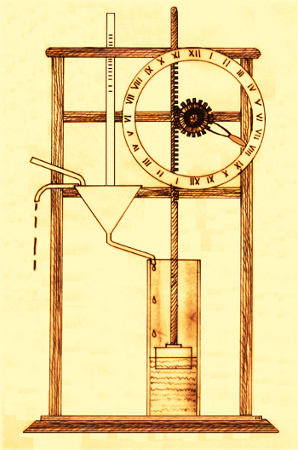Timekeeping
July 1, 2010
The earliest timekeeping device was probably a
tally stick used to mark the passage of days. When a need arose to mark portions of the days, themselves, into intervals, it was probably the
gnomon that sufficed. The gnomon, of course, is just a stick in the ground acting as a sundial. Thereafter, the gnomon became a true
sundial that was calibrated to read accurately spaced hours. There are even two sundials on Mars. These
MarsDials were placed on the Mars
Spirit and
Opportunity rovers. The MarsDial design team included the astronomer
Woodruff Sullivan, author of a history of
history of early radio astronomy [1] that my children bought me for
Father's Day. There's a very large sundial on the campus of
The College of New Jersey, that my son and I examined during our trip to this year's
Trenton Computer Festival.

Sundial at The College of New Jersey.
Of course, sundial timekeeping is a problem on cloudy days and at night.
Water clocks were invented to allow timekeeping during all times of day. The simplest of these is just a graduated container with a small hole that allows water to exit at a slow rate. More elaborate indicating water clocks were invented, including the one shown in the figure. The next development in precision timekeeping was the
pendulum, and now we're getting into some real physics.

Modern Water Clock.
The pendulum was in use for many years as a mechanical aid in tools and other machines before
Galileo Galilei discovered its timekeeping properties. Galileo's interest in the pendulum is traced to his 1582 observation of a swinging candlelight in the Pisa cathedral. As the story goes, after a worker replaced the candle and released the fixture, it swung as a pendulum. Galileo used his own heartbeat to time its period. Galileo's detailed experiments determined that the period of a pendulum is, for the most part, independent of the weight of its bob and the amplitude of its swing (width of travel). If frictional forces are negligible, and the amplitude is small, a pendulum's period is merely proportional to its length L [2]

where g is the Earth's
gravitational acceleration (about 9.8 m/s
2). If the amplitude is large, the period can be expressed as an infinite series in its initial amplitude, θ
o, as expressed in radians

The pendulum reigned supreme as a timekeeper until
quartz crystal electronic oscillators were invented in the early part of the twentieth century. However, the simplicity of the pendulum assured its place in many clocks into the second part of the twentieth century. I worked at a
television station in the late 1960s that had a master pendulum clock for timekeeping. This clock sent electrical synchronization pulses to other clocks in the building. Now, even quartz is being displaced by
atomic clocks that are based on microwave transitions of electron energy levels in isolated atoms, typically in a gas. Refrigerator-sized versions of these have achieved an accuracy of 100 ps/day, and miniature versions are being developed. You can buy your own
benchtop rubidium frequency standard that has better than 500 ppm accuracy over the course of a year for just $2,495.00.
Why all this accuracy? Not only do different technologies enable each other, but they are dependent on each other. Our much beloved
Global Positioning System, a.k.a., GPS, is based on a triangulation method that uses the transit time of signals received from satellites. High positional accuracy can be achieved only when the timekeeping is very precise. Many other types of timekeepers (hourglass, etc.) can be found on
Wikipedia.
There's a lot of science in timepieces, so it's not unusual that a scientist would head an important watch company. Nicholas G. Hayek Sr., who passed away on Monday, June 28, 2010, studied chemistry, physics and mathematics at the
University of Lyon. After obtaining his PhD, he formed an engineering company, Hayek Engineering, but his fame rests in the Swiss watch industry. He brought that industry, kicking and screaming, into the digital watch era, and became a billionaire as CEO of
Swatch.[3]
References:
- Woodruff T. Sullivan, "Cosmic Noise: A History of Early Radio Astronomy," (Cambridge University Press, 2009).
- Wikipedia article on the pendulum.
- Stephen Pope, "Swatch Billionaire Nicolas Hayek, Who Saved The Swiss Watch Industry, Dies," Forbes Blog (June 29, 2010.
Permanent Link to this article